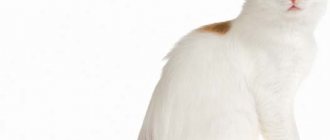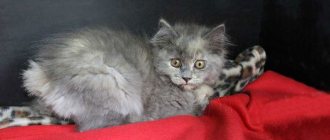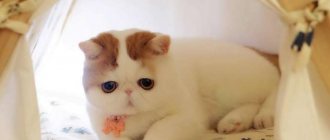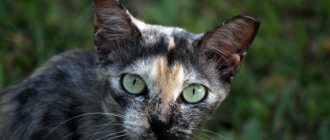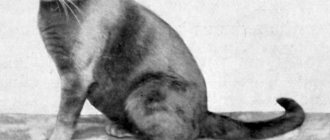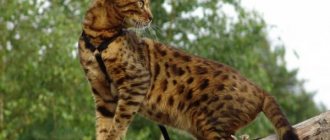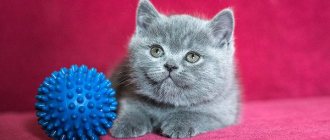Breed Features
Hairless cats are different from other cats, which is important to consider when planning their diet. What makes sphinxes stand out? Breed Features:
- Lack of wool. This leads to the frequent appearance of acne or dermatitis. To prevent disorders, it is important to maintain a balance in nutrients and beneficial elements.
- The speed of metabolic processes due to increased energy expenditure on heating the body, supporting the immune system, and health. For this reason, it is recommended to feed sphinxes more often, maintaining a certain calorie and nutritional content of the diet.
- Indiscriminate eating. Sphynx cats eat whatever comes their way, so it is important to monitor the quality of food. Thus, additives to enhance the taste or aroma of food cause digestive disorders.
- Tendency to problems with hormonal levels. Overfeeding leads to a sharp gain of excess weight, which becomes a common cause of problems with the heart and blood vessels.
If a breed is prone to disorders and diseases, this can easily be avoided by creating a balanced diet. This will keep your pet active, improve health, and reduce susceptibility to pathologies.
Donskoy
The Don Sphynx is a subspecies whose skin is covered with thin short hairs. This creates a plush, velor effect when touching the cat. Sometimes the fluff may be absent, then the sphinx is considered naked. The animals are characterized by medium size and well-developed muscles.
Breeding was carried out in Russia. The subspecies is widespread, but appeared recently. Therefore, Don Sphynxes are distinguished by good health - they rarely suffer from acne, allergies, or digestive disorders. Unpretentiousness in food is also considered a plus. The main thing is not to spoil your pet, but to immediately accustom it to the diet and feeding regime.
Canadian
Canadian Sphynx cats are a subspecies whose kittens are never born with bare skin. Therefore, they are covered with light wool (fluff). With age, its volume increases. These cats are graceful, with moderately developed muscles, of medium size.
The history of the breed begins with kittens in Canada who were born hairless. More than 50 years have passed since that time, which has left its mark on the health of animals. Canadian Sphynx cats have sensitive digestion, which affects the choice of food for the pet. Owners often change food for elderly pets to hypoallergenic, preventive products.
Features of the Sphinx and its menu
Hairless cats need to move a lot to warm their bodies, so they eat everything.
Hairless cats need to move a lot to warm their bodies, so they eat everything to accumulate calories. Owners of the breed will have to make sure that harmful products are out of the pet’s reach: trash cans are closed, medications are hidden.
Another feature of sphinxes is that they do not chew food. Food should be cut into convenient portion pieces, and hard granules should be softened so that the animal cannot injure the esophagus in the process.
Cats have a delicate gastrointestinal tract; not all foods are suitable for them. It is important to monitor possible disorders and promptly remove foods that cause discomfort from the diet. Due to unbalanced nutrition, dermatitis and dysbacteriosis appear.
Choosing a place and dishes
The pet’s health and appetite are affected by both the food itself and the arrangement of the dining area. Choosing a place and dishes is an important undertaking. It’s better to think about this before purchasing a pet. Recommendations for the feeding area:
- place easy-to-clean material under the bowls, as you will need to constantly monitor cleanliness;
- provide free space and access to the site;
- place bowls away from loud household items (washing machine, TV);
- take into account the comfort of your pet - cats do not like to eat when someone is constantly walking nearby, so it is better to arrange a place away from the aisles.
If there are other animals in the house, feeding areas are provided for each pet. The cat will be malnourished without a sense of comfort and security.
The basic requirements for cookware are practicality, safety of materials, and convenience. Bowls allowed:
- made of ceramics - easy to clean and wash, do not slip, but can break;
- stainless steel is a good replacement, but these bowls should only be placed on a stand due to strong sliding.
Why monitor the development of newborn kittens?
It is very important to monitor how newborn kittens develop and know how best to care for babies at different stages of their growth. This will help get rid of many problems associated with animal health.
During the first three weeks of kittens' lives, mother cats themselves feed and care for them. However, control over the full and timely development of small pets is the responsibility of the owner. To do this, you need to regularly weigh the kittens, and also know when they open their eyes, when their first teeth are cut, when they begin to hear, walk and eat solid food.
What to feed a Sphynx kitten
Kittens feed on their mother's milk immediately after birth, but upon transfer to the owner they have to introduce new food. Three types of diet:
- regular foods (meat, vegetables, egg yolks, cottage cheese, rice);
- industrial products (dry and wet food);
- mixed nutrition.
The choice of what to feed a Sphynx kitten affects its proper growth and development. The diet of the subspecies differs little. The main difference is that Don Sphynxes are sometimes allowed to feed fish on a natural diet.
Important! Cats are primarily carnivores, so a proper diet must include sufficient protein. Balance ensures the inclusion of other nutrients, vitamins, and minerals.
Natural diet
A natural diet consists of raw or cooked foods. Three recommendations for Sphynxes: a large amount of meat protein, less carbohydrates, a complete vitamin and mineral complex.
Authorized products:
- every day boiled or raw meat - veal, beef, skinless poultry (turkey, chicken), rabbit;
- offal - chicken or beef (1-2 times a week);
- oatmeal or buckwheat, rice – 3 times a week;
- boiled cabbage, carrots, zucchini, other vegetables;
- greens and unsweetened fruits;
- egg yolks, unsalted cheese, cottage cheese;
- boiled sea fish fillet - only for Don Sphynxes;
- unrefined vegetable oils.
The main rule is that you can only feed cats fresh food. If the pet left a part in the plate, it is thrown away. For the next meal, a new portion is taken.
pros:
- natural products are cheaper than high quality feed;
- satisfying predatory needs for meat;
- variety of diet;
- opportunity to choose fresh, high-quality products.
Minuses:
- difficulties in calculating caloric content and nutritional value;
- regular cooking - once every 1-2 days;
- organizing additional intake of vitamins and minerals.
The first complementary feeding is carried out at 1.5–2 months. The introduction of products is carried out with simultaneous observation of the pet’s reaction. By the age of one year, taste habits are fully formed.
Ready-made feed
Often, ready-made food is chosen for feeding your pet. Industrial products are now represented in 4 classes: Economy, Premium, Super-premium and Holistic. They differ in the quality of ingredients, the proportion of meat protein and price. For feeding sphinxes, veterinarians recommend Premium or Super-premium food. Economy class is strictly prohibited for this breed.
Industrial feeds are presented in 3 forms: dry, semi-moist, wet. It is better for adult animals to alternate dry granules with wet food.
Interesting! Feeding only granular food will wear away tooth enamel. Giving only wet food will cause softening of the gums.
pros:
- convenience, practicality - no need to constantly cook;
- balance, completeness of the diet;
- no need to calculate calorie content or nutritional value;
- high quality ingredients in the appropriate feed class.
Minuses:
- price – buying Premium and Super-premium feed will hit your wallet;
- the likelihood of stumbling upon a fake or stale product.
If the owner chooses industrial products for feeding the cat, then complementary feeding with pates or pastes begins from 1–1.5 months. Upon reaching three months of age, it is necessary to introduce semi-moist food (pieces in gravy or jelly). Dry pads are allowed only after changing teeth.
Caring for a Sphynx cat
Eyes
The absence of eyelashes makes the Sphynx's visual organs especially vulnerable. To prevent inflammation, your cat's eyes should be wiped daily with chamomile infusion, chilled black tea, or simply boiled water. You can use special products from the pet store.
Ears
In ordinary cats, brown discharge in the ears indicates developing diseases. For Sphynx cats, brown plaque on the inner surface of the ear is normal. Once a week, the skin should be wiped with a cotton pad soaked in lotion. After cleaning, the ears are dried and powdered with a special product purchased from a veterinary pharmacy.
Bathing
Canadians need to be washed regularly, but not too often. The optimal regime for bath procedures is once every 14–30 days. For bathing, you can use a special shampoo. Products that are not suitable for Canadian skin may cause allergic reactions and inflammation.
Wash cats with a soft sponge or hand without gloves. Water temperature is 37–39 degrees. The temperature in the room where bath procedures are carried out is also important. You need to make sure that there are no flows of cold air.
Important! A common problem with Canadian Sphynx cats is neglect of anal hygiene. To prevent your pet from soiling objects in the house with fecal residue, you need to wipe its butt and tail with hypoallergenic wipes after using the toilet.
Claws
Canadians need a manicure once every 2 months. Use sharp nippers or rounded scissors to trim the tips of the claws. This procedure is mandatory. If the claws are not trimmed in a timely manner, the cat may injure itself and the skin will become inflamed.
Cold protection
Completely hairless, Canadians are not adapted to the harsh Russian climate. Cats are quite comfortable indoors, but they need special warming clothing to walk outside. It is also necessary to organize a warm bed for sleeping and rest. The best option is a closed house. Additionally, you can organize a comfortable hammock next to the heating radiator.
Sample menu by age
For kittens, it is necessary to create an approximate menu by age, since the needs of a growing body change every month. During this time, you need to decide on the type of diet and start appropriate complementary feeding.
Up to a month
In the first month of life, the kitten must feed on mother's milk, with which it receives antibodies to form strong immunity. It also helps to balance the colonization of the intestines with microflora.
If natural nutrition is not possible, then the baby is fed artificially. For this, an industrial substitute, diluted goat's milk or infant formula is used.
Feeding regimen for kittens up to a month:
- the first 14 days - every 2 hours (10-12 times a day);
- from 15 to 30 days - every 2-3 hours with a break for sleep (8-9 times a day).
During the first month, it is better for the owner to focus on the kitten’s wishes. If he asks for food, then you need to feed him. The daily portion is from 40 to 60 ml. It depends on the size and health status of the baby.
1 month
At 1 month it is allowed to introduce the first complementary foods, which depends on the chosen diet. Products for natural menu:
- cat milk;
- goat milk diluted with warm water;
- lean meat broth;
- boiled minced meat with a homogeneous structure.
If the owner has chosen a commercial diet, then feeding continues with a cat's milk replacer or infant formula. If there is growth retardation, the kitten is given pate or mousse.
The daily portion depends on the rate of growth and development. The amount of food ranges from 45–50 g to 80–90 g. Feeding regimen is 6–7 meals, excluding liquid food (milk).
2 months
At 2 months, kittens begin to grow stronger and grow faster. Nutrition Features:
- With a natural menu, liquid food (milk, broth) and minced meat remain. New products are being included: fermented milk products, chopped raw beef after preliminary freezing.
- Commercial diets retain cat milk replacer or infant formula. Special canned food for kittens is introduced on an ongoing basis.
The daily portion increases to 65–100 g. The number of meals is reduced to 5–6 times, excluding milk or industrial substitute. At this age, vaccination begins, so a slight weight loss may be observed, which is considered normal.
3 months
When they reach three months of age, kittens begin to be separated into new families. This is accompanied by stress for the pet, so it is necessary to ensure a comfortable transition. It is advisable for the owner to find out what the breeders fed the baby. Innovations in diets:
- The natural menu becomes more varied and nutritious. It is allowed to introduce cottage cheese, quail eggs, raw meat in pieces, grated vegetables (carrots) or apples.
- The commercial diet is supplemented with semi-moist kitten food (pieces in jelly or gravy).
Origin of the Canadian Sphynx
Abroad, these cats are simply called “Sphynx”. The prefix “Canadian” is used only in Russia.
The hairlessness mutation (the gene was named hr) was identified in Canada in 1966. In Ontario, an ordinary mongrel cat gave birth to a hairless kitten, wrinkled like a dried plum. It was called Prune (Prune) - Prune.
After Prune mated with his mother, hairless kittens were born in the litter. To consolidate the mutation, he was repeatedly bred with hairless cats. But the experiment failed - due to inbreeding, the kittens died and were sick. In 1971, the breeding of hairless cats was suspended.
Another hairless kitten was born on the border with Canada, in Minnesota in 1975, from an ordinary short-haired cat. It was called Epidermis. Epidermis' mother will give birth to another hairless kitten a year later, this time a girl. Epidermis is purchased by a hobby breeder from San Francisco, David Mare. To pair with him, he buys a hairless cat from Holland named Alopecia Totalis. David also had a third hairless cat from North Carolina, which was successfully exhibited at shows. But no information has been preserved about the descendants of David Mair's cats.
Canadian Sphynx
In 1978, in Toronto, Canada, Siamese cat breeder Shirley Smith picked up a cat with 2 kittens on the street, one of which was naked. The black and white hairless cat was named Bambi, he was neutered and lived for 16 years (until 1994).
In 1980, Bambi's mother brings a new litter, containing two hairless cats. These animals are probably undocumented descendants of Prune. They travel to Holland, where they are given the names Punkie and Paloma.
It was the cat Punkie who was bred with a Devon Rex cat. The result of the mating was hairless kittens in the first generation.
But let's return to America. Hairless kittens begin to be born on a Minnesota farm in 1975. In 1981, the Persons sold two adult hairless cats to Stardust Cattery in Oregon to breeder Kim Muesk. They were called Epidermis and Dermis. This has created some confusion, with a cat named Epidermis being confused with David Mair's Epidermis the cat.
Hairless cats were called “lunar” until the original and mysterious name “Sphinx” was invented
Kim mated hairless cats with different cats, but all the kittens were covered with fur. Then, on the advice of another felinologist, she acquired a Devon Rex. So Sphynxes were bred using this breed both in Holland and in the USA.
In 1985, a Sphynx nursery appeared in Texas, and interest in them grew. Hairless cats continue to be crossed with Devon Rex and American Shorthair cats, increasing the gene pool of the population. Nurseries actively exchange kittens.
The international organization for the breeding and development of new breeds of cats (Cat Fanciers' Association, CFA) recognized Sphynxes only in 1998. In 2002, the breed standard for judging was approved.
Canadian Sphynx on a walk
Until 2010, matings of Canadian Sphynxes with Devon Rexes were allowed. Now the breed is closed for interbreed matings. A Canadian Sphynx is considered purebred if its ancestors were Sphynxes in 4 generations.
Vitamins and supplements
Vitamins and supplements are an important part of a proper cat diet. They help replenish nutrients, which keeps your pet healthy. Types and examples of additives:
- natural sources - beef or chicken liver, vegetable oils, yeast, herbs or grass, vegetables;
- pharmaceutical preparations - vitamin complexes, products with Omega-3, fish oil, feed additives.
Among pharmacy vitamins, the manufacturer Polidex is distinguished. The company produces 4 types of complexes:
- Super Wool – for leather and wool;
- Gelabon plus Glucozamine – to strengthen the bones;
- Immunity Up – for immunity;
- Multivitum.
An important amino acid for kittens is taurine. It is usually included in ready-made feeds. Natural products with taurine: offal, turkey, sea fish, homemade yogurt.
Canadian Sphynx owner reviews
“We got a cat with the habits of a dog! He recognized me as the hostess; my relationship with my husband was cool. He responds to his nickname, jumps on his shoulder on command, and greets him from work. Calmly tolerates hygiene procedures - bathing, ear cleaning. There is no fur in the apartment, and for me the Canadian Sphynx is the best breed in the world. The only thing is that it smells a lot when going to the toilet, and often. Don’t even try to save on filler.”
“Perhaps our Kasia is not a purebred Canadian, since she was taken without documents. But it looks amazing - like an elegant Egyptian figurine. Constantly meows and talks. And she’s ready to eat all the time, voracious like an elephant. Climb onto the shoulder, head, chest. In this case, in the heat of the moment, he may begin to climb his bare leg. He loves to sit on my laptop - it’s warm, and on the stove! I can't wean it off. She carries toys in her teeth and is very smart. Tender, affectionate, not earthly"
“Bucks are with me everywhere, I’ve come to terms with it. It doesn’t matter what I do - cook, wash, wash the floor - he wants to help me or at least watch. She sleeps on the bed and bothers my husband and me. Walking across the face or biting the leg is normal for him. It’s a shame to kick out the bald guy, he’s like a child. In general, at night the devil wakes up in it, jumps on the furniture, turns the whole house upside down. We love, we forgive"
“My Canadian is a fiend. No, he is not aggressive, quite the opposite. Always climbs into your arms, wants to be petted and kissed. But my life revolves around a cat, if I describe all his pranks, I’d get a whole book. He rides on curtains and breaks furniture, ignoring the scratching post. Tears off the wallpaper. He pulls clothes off the dryer. Destroys toilet paper. Flushes the toilet because it's fun. Yes, he taught himself to use the button! Steals food. He throws everything off the shelves and off the table. At first I cried and wanted to return Benny to the breeder. Then I got used to it. Life is boring without him! I’ll go kiss your warm bald belly.”
“We have a girl, Cleopatra, of the Canadian Sphynx breed. I warn everyone that sphinxes are not cats, they are children. They need to be taken care of, they need to be loved. If you don’t have time for a pet, don’t torture yourself or the animal - choose another breed.”
Water
The average daily water consumption is 45–55 ml per 1 kg of body weight. It changes depending on the diet. When feeding dry pads, the quantity will need to be increased, since the pellets contain almost no moisture. On a natural diet, the need is lower, since liquid comes from foods.
The main rule is that the water must be clean, fresh, free of foreign tastes and odors. The contents of the drinking bowl are changed every day. If food residue gets in, you will need to change it more often. Drinking bowls are placed next to the bowl or in another place with free access.
Description of the Canadian Sphynx breed
Sphinxes are every photographer's dream. They look really unusual. Not only due to the lack of fur, the overall silhouette of Canadians is also distinctive.
Graceful, but not fragile. Quite strong and muscular animals of medium size. The weight of an adult Sphynx is 3-3.5 kg for cats and 3.5-5 kg for cats.
The wedge-shaped head with pronounced cheekbones is decorated with huge ears. Wide apart, erect, they should be very large. The eyes, which are described as having the shape of a lemon, should also be large. The eyes of these cats are widely spaced and do not have protection in the form of eyelashes. The eye color matches the coat. For example, white or color-point animals can have blue eyes.
Sphynx cats have well-developed cheek pads
Sphynxes are built quite harmoniously, the length of the paws is proportional to the length of the body. The hind legs are slightly longer than the front legs. These cats have thick paw pads and long toes. Therefore, sphinxes walk as if on tiptoes, and their paws have an oval silhouette.
Sphynx dogs have a round tummy, but signs of obesity are unacceptable.
A feature of sphinxes that touches their owners is their tail. Long and flexible, like a whip, it curls into a steering wheel like a chameleon's tail. Usually the cat presses it to its side with a kind of curl (perhaps so as not to lose precious heat).


